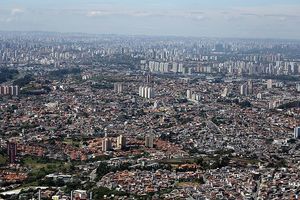Amazon – world of waters
B
razil boasts the greatest river in the world. Though not quite the longest at 4,050 miles, the Amazon is without doubt the mightiest of waterways with a drainage area of 2,500 square miles and a water flow of 80,000 tons per second (enough to flood the whole of England six inches deep in half an hour).
Early explorers dubbed it the Fresh Water Sea, because freshwater at the mouth extends up to 180 miles from the shore.
Rising 80 miles from the Pacific, and tapping nine countries in South America and 60% of Brazil, it takes two months before disgorging into the Atlantic where its mouth is 200 miles wide.
Eight of its tributaries are over 1,000 miles long, three more than 2,000 miles, and two over 3,000 miles long.
If you stood at the junction of the Amazon with its Madeira tributary, you would be able to see the other bank of this tributary, but that of the Amazon would be over the horizon.
Navigation
Over the last 500 miles of its descent, the Amazon drops only an inch every eight miles. At flood season the river rises some 60 feet at Manaus, 1,000 miles upstream from the mouth.
This produces a ‘drowned forest’ with only the tops of the trees visible, and houses along the banks have to be built on stilts. I have cooked a meal at the top of a tree for want of easy access to terra firma.
In flood season, ocean-going ships ply direct to Iquitos in Peru. When ships go aground for failing to observe the dates of low water level, they might have to wait weeks before new water arrives to lift them off the sand banks.
A phenomenon of special tourist attraction is the periodical tidal wave known as Pororoca which commonly takes place at the equinoxes, when the sun and moon are aligned on the same side of the earth.
The wave, up to 20 feet high, advances at 10 to 15 mph upstream, uprooting trees in its wake and producing a deafening roar audible up to two hours before arrival (which gives river craft time to seek safety).
Before the Pororoca arrives there is a great calm when, it is said, even birds stop singing!
Forest hazards
Not only does Brazil possess the largest river, but also the largest rain forest. It is fast disappearing but remains forbidding terrain.
Roy Challacombe of the West Amazon Mission writes: ‘We passed the night in a shelter that let in all the rain, so we set off in the forest the next morning in sodden clothes.
‘After four hours’ trudging through dense growth, we reached the Indian camp but there were no Indians! After resting we turned to go back … but we were lost!
‘The trail had disappeared and we were hemmed in on all sides by an everlasting wall of trees and undergrowth.
‘We struck out in different directions to find the trail, but without success. Our eyes became blurred searching in the red-brown, soggy, spongy mess of rotten wood and leaves that comprised the forest floor.
‘After two hours’ searching we were almost worn out, and the sun was setting low, but we had to keep pushing on …
‘Soon we were no longer searching for a trail, but trying to get out of an area of sucking, oozing mud and fallen trees. Praise God that before darkness closed in we were all able to free ourselves … and we reached a place where there were plenty of palm tree leaves.
‘The night passed peacefully, although we spent the whole time scratching … overwhelmed by a multitude of tiny biting insects. What a relief it was to see the sun rise.’
Sons of the forest
The true sons of the forest are the Indians. When Brazil was first discovered their population was an estimated 1,100,000, distributed among 1,400 tribes.
Today, due largely to outside influences, the white man’s diseases, and vices, the population has fallen to 350,000.
Around 1910 and earlier, when rubber became commercially valuable, large numbers from NE Brazil flocked to the Amazon basin to tap the Hevea (rubber) trees.
To eliminate interference from the Indians, whole villages were decimated and terrible atrocities perpetrated on the Rio Putumayo, so that the Christian press in the UK strongly protested against such cruelties.
I should here mention that my father, Rev. O. R. Walkey, was sent out to investigate, under the auspices of the Bible Society. His missionary zeal was kindled and he founded the West Amazon Mission in 1953 (later incorporated into the Unevangelised Fields Mission).
Today missionary work among the Amazon Indians is carried out by some twenty different linguistic groups. But of the 258 tribes, 113 have no missionary presence, and most Indians have never heard the name of Jesus Christ.
Occupied with God
However, 34 tribes now possess the New Testament in their mother tongue.
The Hixkariana tribe, where Desmond and Grace Derbyshire worked with the Wycliffe Bible Translators, is but one such tribe.
When US politician Robert Kennedy visited the tribe he asked its chief what he liked doing best in life. His simple answer was one of the most challenging sermons I have ever heard.
The very best thing anyone could possibly do in life, he said, was to be occupied with God.
His answer showed him to be one of that number – from all nations, kindreds and tongues – who will one day stand before the throne of God and of the Lamb, to see his face and serve him for ever.











